Gujarat Board GSEB Textbook Solutions Class 12 Maths Chapter 13 Probability Ex 13.4 Textbook Questions and Answers.
Gujarat Board Textbook Solutions Class 12 Maths Chapter 13 Probability Ex 13.4
Question 1.
State which of the following are not probability distribution of a random variable. Give reasons for your answers.
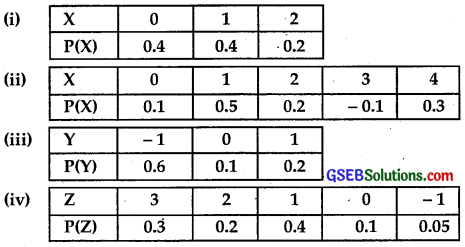
Solution:
(i) Sum of probabilities = 0.4 + 0.4 + 0.2 = 1.
∴ This distribution is a probability deistribution.
(ii) One of the probabilities – 0.1 is negative.
∴ It is not a probability distribution.
(iii) Sum of probabilities is 0.6 + 0.1 + 0.1 = 0.9 ≠ 1.
∴ The given distribution is not a probability distribution.
(iv) Sum of probabilities = 0.3 + 0.2 + 0.4 + 0.1 + 0.5 = 1.05 > 1
∴ It is not a probability distribution.
![]()
Question 2.
An urn contains 5 red and 2 black balls. Two balls are randomly drawn. Let X represents the number of black balls. What are the possible values of X, if X is a random variable?
Is X a random variable?
Solution:
These two balls may be selected as RR, RB, BR, BB, where R represents red and B represents black ball.
Variable X has the value 0,1,2, i.e., there may be no black balls, may be one black ball, or both the balls are black.
Yes, X is a random variable.
Question 3.
Let X represents the difference between the number of heads and the number of tails obtained, when a coin is tossed 6 times.
What are the possible values of X?
Solution:
When a coin is tossed 6 times, we obtain the number of heads and tails as follows:
Corresponding values of X are shown here.

![]()
Question 4.
Find the probability distribution of:
(i) number of heads in two tosses of a coin.
(ii) number of tails in the simultaneous tosses of three coins.
(iii) number of heads in four tosses of a coin.
Solution:
(i) When two tosses of a coin are there:
Sample space = {TT, TH, HT, HH}
Zero success ⇒ No head ⇒ Two tails (TT)
∴ P(0) = \(\frac{1}{2}\) × \(\frac{1}{2}\) = \(\frac{1}{4}\).
One success ⇒ 1 head or 1 tail (TH, HT)
P(1) = \(\frac{1}{2}\) × \(\frac{1}{2}\) + \(\frac{1}{2}\) × \(\frac{1}{2}\)
= \(\frac{1}{4}\) + \(\frac{1}{4}\)
= \(\frac{1}{2}\).
Two success ⇒ Both heads (HH)
P(2) = \(\frac{1}{2}\) × \(\frac{1}{2}\) = \(\frac{1}{4}\).
∴ Probability Distribution

(ii) When three coins are tossed simultaneously:
Sample space = {TTT, TTH, THT, HTT, THH, HTH, HHT, HHH}
Zero success = No tail = All head {HHH}
∴ P(0) = \(\frac{1}{2}\) × \(\frac{1}{2}\) × \(\frac{1}{2}\) = \(\frac{1}{8}\).
1 success = 1 tail and 2 heads
= {THH, HTH, HHT}
∴ P(1) = 3 × \(\frac{1}{2}\) × \(\frac{1}{2}\) × \(\frac{1}{2}\) = \(\frac{3}{8}\).
1 success = 1 tail and 2 heads
= {THH, HTH, HHT}
2 success = 2 tail and 1 head
= {TTH, THT, HTT}
P(2) = 3 × \(\frac{1}{2}\) × \(\frac{1}{2}\) × \(\frac{1}{2}\) = \(\frac{3}{8}\).
3 success = All the tails = {TTT}
P(3) = \(\frac{1}{2}\) × \(\frac{1}{2}\) × \(\frac{1}{2}\) = \(\frac{1}{8}\).
∴ Probability distribution is:
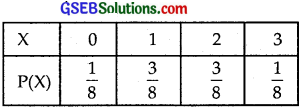
(iii) When a coin is tossed 4 times:
Zero success = No head = All are tails {TTTT}
= \(\frac{1}{2}\) × \(\frac{1}{2}\) × \(\frac{1}{2}\) × \(\frac{1}{2}\) = \(\frac{1}{16}\).
1 success = 1 head 3 tails
= {HTTT, THTT, TTHT, TTTH}
P(1) = 4C2 × \(\frac{1}{2}\) × \(\frac{1}{2}\) × \(\frac{1}{2}\) × \(\frac{1}{2}\) = \(\frac{4}{16}\) = \(\frac{1}{4}\).
2 success = 2 heads and 2 tails
= {HHTT, HTHT, HTTH, THHT, THTH, TTHH}
∴ P(2) = 4C2 × \(\frac{1}{2}\) × \(\frac{1}{2}\) × \(\frac{1}{2}\) × \(\frac{1}{2}\) = \(\frac{6}{16}\) = \(\frac{3}{8}\).
3 successses = 3 heads and 1 tail
= {HHHT, HHTH, HTHH, THHH}
∴ P(3) = 4C3 × \(\frac{1}{2}\) × \(\frac{1}{2}\) × \(\frac{1}{2}\) × \(\frac{1}{2}\) = \(\frac{4}{16}\) = \(\frac{1}{4}\).
4 successes = All the heads = {HHHH}
P(4) = \(\frac{1}{2}\) × \(\frac{1}{2}\) × \(\frac{1}{2}\) × \(\frac{1}{2}\) = \(\frac{1}{16}\).
Thus, the probability distribution is:

![]()
Question 5.
Find the probability distribution of the number of successses in two tosses of a dice, where a success is defined as
(i) number greater than 4.
(ii) six appeared on at least one dice.
Solution:
(i) When a number on each dice is 1, 2, 3, 4.
Such cases are: {(1, 1), (1, 2), ……………, (2, 1), (2, 2), ……………., (4, 4))} = 16 cases
Total number of cases in sample space
= 6 × 6 = 36.
∴ P(0) = \(\frac{16}{36}\) = \(\frac{4}{9}\).
1 success = 5 or 6 on one dice and 1, 2, 3, 4 on the other dice = 16
∴ P(1) = \(\frac{16}{36}\) = \(\frac{4}{9}\).
Two successes = 5 or 6 on both dice
= (5, 6), (6, 5), (5, 5), (6, 6)
∴ P(2) = \(\frac{4}{36}\) = \(\frac{1}{9}\).
∴ Probability distribution is as follows:
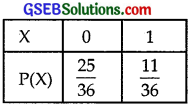
(ii) Zero success = 6 does not appear on any dice.
= 1, 2, 3, 4, 5 appear on both sides
∴ Number of such cases = 25
P(0) = \(\frac{25}{36}\).
1 success ⇒ 6 appears on one dice and 1, 2, 3, 4, 5 appears on both dice
∴ Number of such cases = 25
P(0) = \(\frac{25}{36}\).
1 success ⇒ 6 appears on one dice and 1, 2, 3, 4, 5 appears on the other dice.
Number of cases = 10.
2 successes ⇒ 6 appears on both dice {6, 6}
Number of such cases = 1.
Number of cases, when there is at least one ‘six’ appears
= 10 + 1 = 11.
∴ Probability of getting at least 1 six = \(\frac{11}{36}\).
∴ Probability distribution is:

![]()
Question 6.
From a lot of 30 bulbs, which include 6 defectives, a sample of 4 bulbs is drawn at random with replacement.
Find the probability distribution of number of defective bulbs.
Solution:
There are 30 bulbs, which include 6 defective bulbs.
Probability of getting a defective bulb = \(\frac{6}{30}\) = \(\frac{1}{5}\).
Probability of getting a good bulb = 1 – \(\frac{1}{5}\) = \(\frac{4}{5}\).
Let X denotes variable of defective bulbs in a sample of 4 bulbs.

∴ Probability distribution of defective bulbs is:
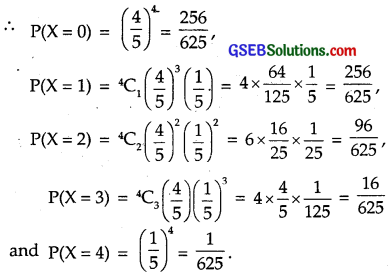
Question 7.
A com is biased so that the head is 3 times as likely to occur as tail. If the coin is tossed twice, find the probability distribution of tails.
Solution:
When the coin is tossed, the head occurs 3 times the tail occurs.
Let the tail occurs x times.
∴ Head occurs 3x times.
So, total number of cases = x + 3x = 4x.
∴ Probability of getting a head = \(\frac{3x}{4x}\) = \(\frac{3}{4}\).
∴ Probability of getting a tail = \(\frac{x}{4x}\) = \(\frac{1}{4}\).
When no tails occurs, the probability of getting {HH}
= \(\frac{3}{4}\) × \(\frac{1}{4}\) + \(\frac{1}{4}\) × \(\frac{3}{4}\) = \(\frac{3}{16}\) × 2 = \(\frac{3}{8}\).
The probability of getting both tails
P(2) = \(\frac{1}{4}\) × \(\frac{1}{4}\) = \(\frac{1}{16}\).
∴ Probability distribution of occuring tails:

Question 8.
A random variable X has the following probability distribution:
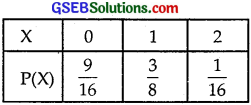
Determine:
(i) k’
(ii) P(X< 3) (iii) P(X > 0)
(iv) P(0 < X < 3)
Solution:
(i) Sum of probabilities = 1
i.e; o + k + 2k + 2k + 3k + k2 + 2k2 + 7k2 + k = 1
or 10k2 + 9k = 1 or 10k2 + 9k – 1 = 0
⇒ (k + 1)(10k – 1) = 0
∴ k = – 1 or k = \(\frac{1}{10}\)
k ≠ – 1 ∴ k = \(\frac{1}{10}\)
∴ The probability distribution is:

![]()
Question 9.
The random variable X has a probability distribution P(X) of the following form, where k is some number:
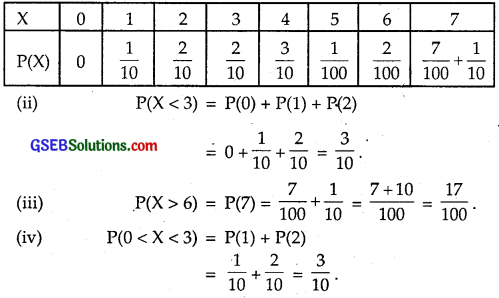
(a) Determine the value of k.
(b) Find P(X < 2), P(X ≤ 2), P(X ≥ 2).
Solution:
(a) Sum of probabilities = 1
∴ k + 2k + 3k = 1 or 6k = 1
⇒ k = \(\frac{1}{6}\).
The probability distribution is as given below:

Question 10.
Find the mean number of heads in three tosses of a fair coin.
Solution:
Let H denotes the success of getting a head.
Sample space {TTT, THH, THT, HTT, THH, HTH, HHT, HHH}
Zero success = {TTT}

Question 11.
Two dice are thrown simultaneously. If X denotes the number of sixes, find the expectation of X.
Solution:
Let X denotes the number sixes.
Probability of getting one six on one dice = \(\frac{1}{6}\).
Probability of getting 1, 2, 3, 4 or 5 on a dice = \(\frac{5}{6}\).
0 success ⇒ Six does not appear on any dice.
∴ Probability of getting 1, 2, 3, 4, 5 on both dice
= \(\frac{5}{6}\) × \(\frac{5}{6}\) = \(\frac{25}{36}\).
i.e., P(0) = \(\frac{25}{36}\).
One six on one of the dice will occur as (Six, Non-six), (Non- six, Six).
∴ Probability of getting a success
P(1) = \(\frac{1}{6}\) × \(\frac{5}{6}\) + \(\frac{5}{6}\) × \(\frac{1}{6}\) = \(\frac{10}{36}\).
Probability of getting sixes on both dice
P(2) = \(\frac{1}{6}\) × \(\frac{1}{6}\) = \(\frac{1}{36}\).
∴ Probability distribution is:
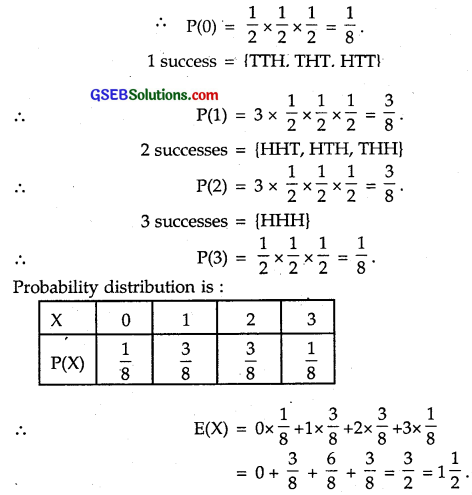
![]()
Question 12.
Two numbers are selected at random (without replacement) from the first six positive integers.
Let X denotes the larger of the two numbers obtained. Find E(X).
Solution:
There are six numbers 1, 2, 3, 4, 5, 6.
One of them is selected in 6 ways.
When one of the numbers has been selected, 5 numbers are left.
One number out of 5 may be selected in 5 ways.
∴ No. of ways of selecting two numbers without replacement out of 6 positive integers = 6 × 5 = 30.
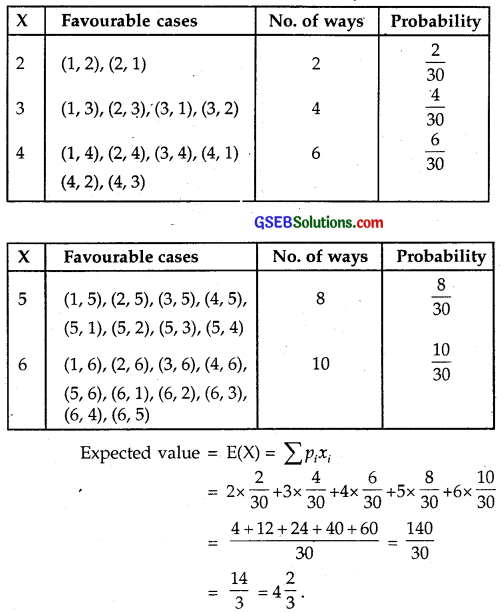
Question 13.
Let X denotes the sum of the numbers obtained, when two fair dice are rolled. Find the variance and standard deviation of X.
Solution:
When two dice are rolled, the number of exhaustive cases = 6 × 6 = 36.
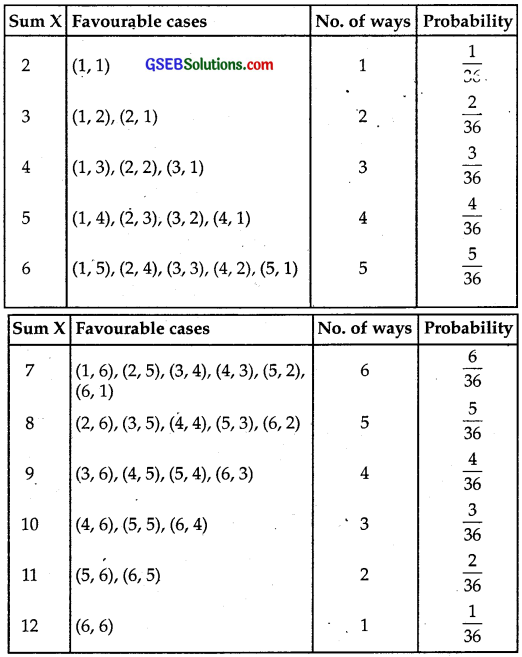
∴ Probability distribution:
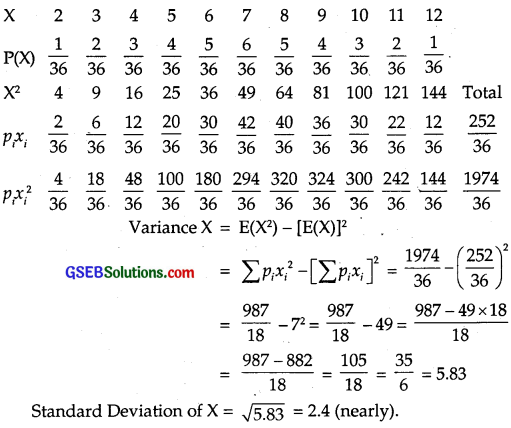
Question 14.
A class has 15 students whose ages are 14, 17, 15, 14, 21, 17, 19, 20, 16, 18, 20, 17, 16, 19 and 20 years.
One student is selected in such a manner that each has the same chance of being chosen and the age X of the selected student is recorded. What is the probability distribution of the random variable X?
Find the mean, variance and standard deviation of X.
Solution:
There are 15 students in a class. Each has the same chance of being choosen.
The probability of each student to be selected = \(\frac{1}{15}\).
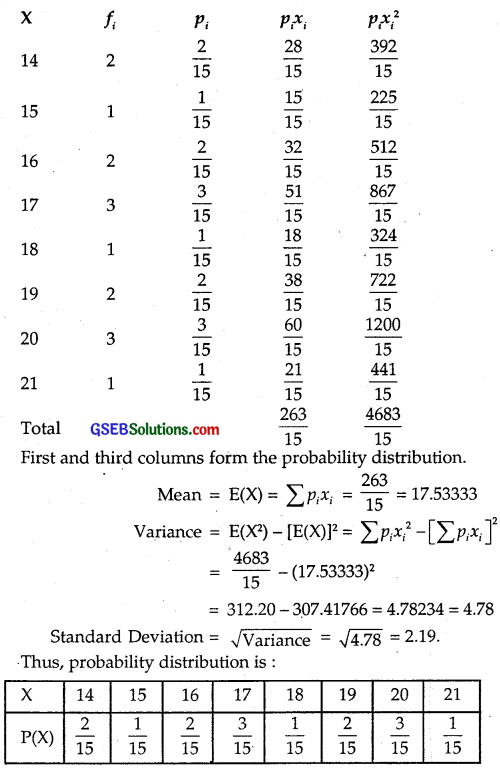
Mean = 17.53, Variance = 4.78, S.D. (X) = 2.19.
Question 15.
In a meeting, 70% of the members favojir and 30% oppose a certain proposal. A member is selected at random and we take X = 0, if he opposed and X = 1, if he is in favour.
Find E(X) and Var(X).
Solution:
Here, the variable values are 1 and 0 and the probability of occurrence is 70% = 0.7 and 30% = 0.3.
Probability distribution is:
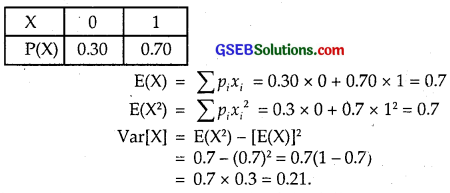
![]()
Choose the correct answer in each of the following:
Question 16.
The means of the numbers obtained on throwing a dice having written 1 on three faces, 2 on two faces and 5 on one face is
(A) 1
(B) 2
(C) 3
(D) \(\frac{8}{3}\)
Solution:
The variables are 1, 2 and 5.
1 is written on 3 faces.
∴ Probability of getting 1 = \(\frac{3}{6}\) = \(\frac{1}{2}\).
2 is written on two faces.
∴ Probablility of getting 2 = \(\frac{2}{6}\) = \(\frac{1}{3}\).
5 is written on one face.
∴ Probability of getting 5 = \(\frac{1}{6}\).
Probability distribution is:
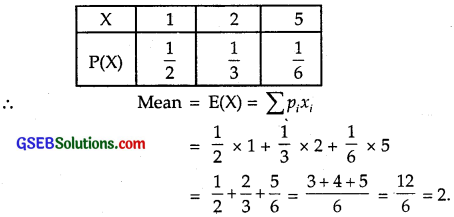
∴ Part (B) is the correct answer.
![]()
Question 17.
Suppose that two cards are drawn at random from a deck of cards. Let X be the number of aces obtained. Then, value of E(X) is
(A) \(\frac{37}{221}\)
(B) \(\frac{27}{221}\)
(C) \(\frac{1}{13}\)
(D) \(\frac{2}{13}\)
Solution:
(i) When two cards are drawn, let no ace occurs.
Two non ace cards may be drawn in 48C2 ways
= \(\frac{48×47}{2}\) = 24 × 47 = 1128.
Out of 52 cards, any two cards may be drawn in 52C2
= \(\frac{52×51}{2}\) = 26 × 51 = 1326 ways
∴ Probability of getting no ace = \(\frac{1128}{1326}\).
(ii) One ace and one non-ace cards may be drawn in
4C1 × 48C1 = 4 × 48 = 192 ways.
∴ Probability of getting one ace and one non-ace card
= \(\frac{1128}{1326}\).
(iii) The number of ways of drawing two aces = 4C2 = 6
∴ Probability of getting 2 aces = \(\frac{6}{1326}\).
∴ Probability distribution is:
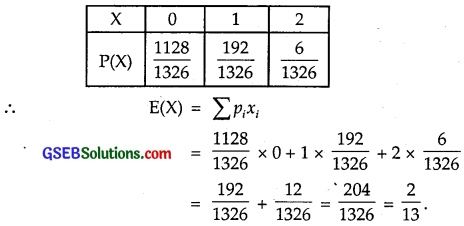
∴ Part (D) is the correct answer.